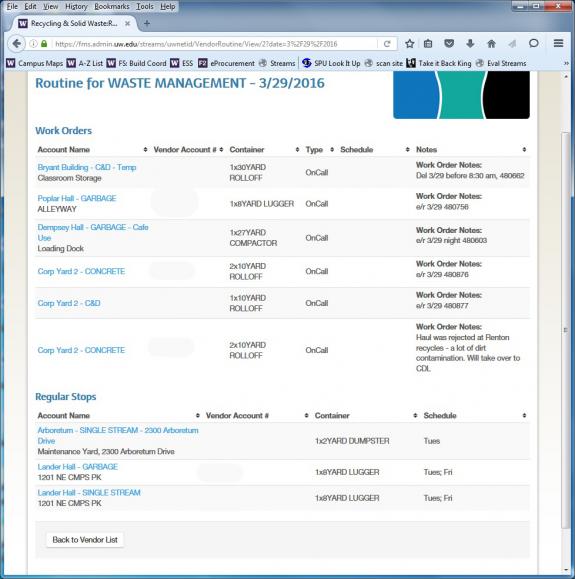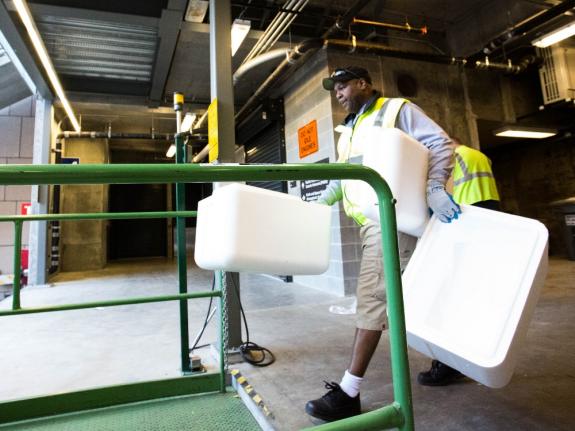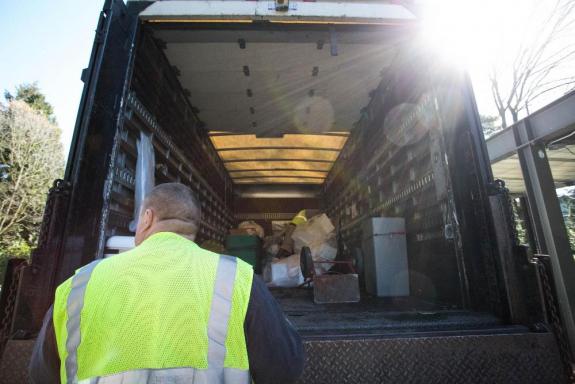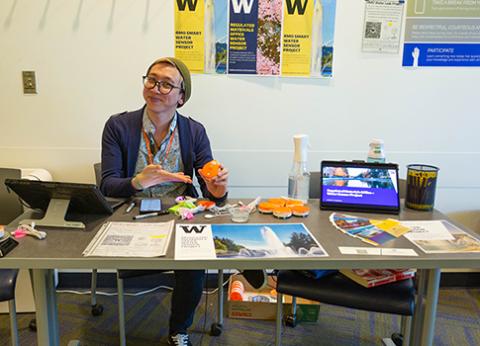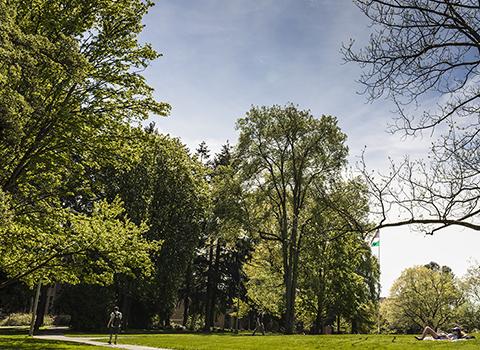Streamlining with streams

Chris Forbes and David Speed from UW Recycling collect styrofoam from outside the Molecular Engineering and Sciences Building in Seattle, Wash. on April 1, 2016.
For the past few months, UW Recycling has been using their new application, Streams, to better connect their administrative office to crews in the field. Through smart phones and tablets, Streams enables employees across campus to access their collection routes online, and log changes that occur throughout their day.
When the crew can’t access a garbage or recycling bin, or additional equipment is needed, Streams is the one stop shop to track it all.
Building and container type information – such as if a building has any e.Media bins, how many trash containers, and where outdoor solar bins are located – are all embedded in the application.
“We were trying to create something that really works for us,” said Liz Gignilliat, UW Recycling’s program coordinator.
UW Recycling, UW-IT, and Facilities Services began discussing the switch to Streams in September 2014. Phase one of the program – replacing the previous system, Wheels – began in January 2015.
The crew is now able to log billable start and end times on the job. They can write comments within the system with updates about specific work requests, and ultimately, communicate more efficiently.
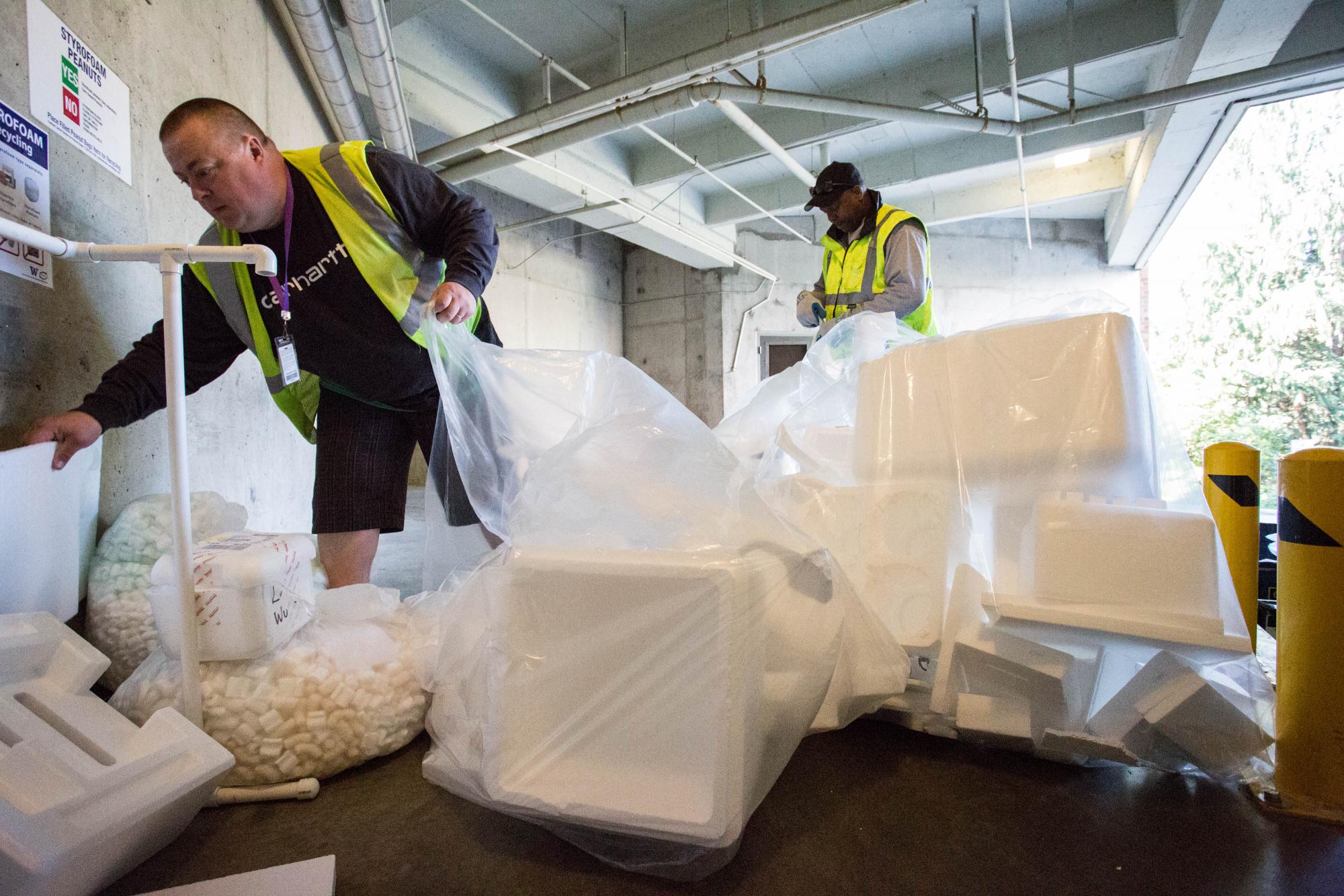
Chris Forbes and David Speed from UW Recycling work at the loading dock outside of the Molecular Engineering and Sciences Building on April 1, 2016 in Seattle, Wash.
Wheels, which was created in 1997, became outdated and didn’t have strong usability.
Previously, customer emails were all manually entered in the system, scheduled, and then printed out to distribute to multiple people within the department. Once these job cards were turned in to the administrative office, the program coordinator had to manually mark it in Excel and in the Wheels system. It was an extensive work flow process.
“It could go wrong in so many different places,” Gignilliat said.
UW Recycling also wanted to cut out a main part of the workflow: paper.
In Fiscal Year 2014, nearly 4,000 sheets of paper were used throughout the workflow process. An average of 103 minutes per month were spent entering vendor requests in Wheels, and service requests could take up to 30 seconds to log.
After Streams was implemented, the log time was cut down to just eight seconds.
The team also wanted to give crew members access in real time to route information and job changes.
Streams funnels work orders and requests that are made by phone, email, or through an online form. Right now, using their mobile devices, crews are able to see job details and route information while in the field. Once the route is complete, it’s recorded in one click. Virtually no paper is involved.
“Everyone on our team got to test [Streams] and provide feedback,” Gignilliat said.
The administrative team first demoed the application in June 2015. The team gave feedback to UW-IT, and changes were made up until late 2015. Meanwhile, staff began testing out their new mobile devices to become familiar with the system features. Internal training for Streams started in August 2015, and soon after, the UW Recycling staff voted on their final logo. The system officially went live on Nov. 2, 2015.
Meetings have continued throughout the year, filled with feedback, suggestions, and noting system limitations. Even after the initial launch of Streams, crews discovered the need for features that hadn’t come up in the initial design process. For example, the crew members wanted an undo button if a misstep had been made in the logging process.
In the spirit of continuous improvement, UW-IT and UW Recycling logged these ideas for a second phase of the program. Phase two launches later this week with an improved online request form.
Customers will soon be able to use their UW NetID to fill out online request forms, which will allow them to view the status of their requests, request history, and make changes or add services to previous requests. By allowing editing access to forms, fewer forms will need to be redone from scratch.
Within the form itself, customers will no longer have to manually enter the full building name to fill out a service request. Instead of typing PAB for the Physics/Astronomy Building, the list will display full building names to ensure accuracy and clarity in the work orders.
After phase two rolls out, Streams will continue to see improvements. The team hopes to create additional reporting functions, provide drivers with route mapping, and simplify the process of sending service requests to vendors.
